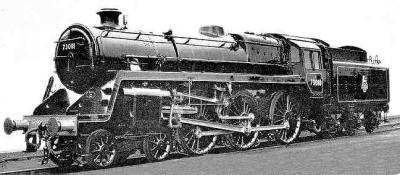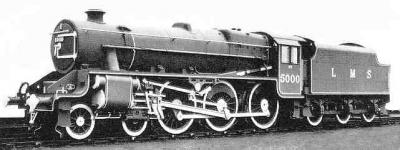The BR Standard class 5 was a development of the LMS Black 5. Major visible differences from the Stanier design were an increase in driving wheel diameter to 6’2”, and the raised running plate that characterised all the BR standard classes. Less apparent were changes to ease maintenance - self-cleaning smokebox and a rocking grate. Design lead was at Doncaster and the first batch was built at Derby in 1951. Construction continued between 1953 and 1957, mostly at Derby but with batches also built at Crewe and Doncaster.
73050 was the first of the third Derby batch, outshopped in April 1954. Before entering service, the loco, then unnamed, was exhibited at the London International Railway Congress in May 1954. It then moved to Bath, Green Park, where it took up duties on the Somerset and Dorset Line. For this, 73050 was fitted with the high-capacity BR1G tender which it retains to this day.
After 10 years on the S&D, 73050 moved to Shrewsbury in 1964. There followed 4 years of intermittent work, storage and moves to Agecroft and Patricroft sheds in Manchester ending finally in withdrawal from service in July 1968.
Also in 1968, the reverend Richard Paten was looking for a steam engine to be placed on a plinth outside Peterborough Technical College, acknowledging the city’s links with railways and steam locomotives. 73050 was chosen as the ‘best of the bunch’ for preservation and bought by Paten for the scrap value of £3,000. Although BR steam had been finished on 11th August 1968, BR allowed the locomotive to be moved under its own power to Peterborough in September that year. On inspection the loco was found to be in such good condition that it was decided to attempt to keep it in running order.
The Peterborough Locomotive Society (PLS) was formed to look after the engine. Initially worked-on at Baker Perkins’ Westwood site and later (1971) at the British Sugar Factory, by 1972 the loco was able to be steamed and the PLS renamed itself Peterborough Railway Society (PRS) Also in 1972, 73050 was named “City of Peterborough”. The following year, Rev Paten donated the engine to the city, who promptly handed it back to the PRS on a 99-year lease. The loco was operated by the PRS during 1974 and 1975 but was withdrawn from service in 1975 in need of overhaul.
Local Engineering company Peter Brotherhood Ltd. offered to undertake the overhaul as an apprenticeship project and this was done between 1977 and 1980, when the loco was returned to the railway (by now called the Nene Valley Railway) painted in BR lined Brunswick green livery. Not strictly authentic for 73050, some class members had acquired the livery following overhaul at Swindon works.
In this state, the loco ran for 7 years. A highlight was when driven by HRH Prince Edward during the opening of the Orton Mere to Peterborough Nene Valley section. Towards the end of the 80’s it was apparent that another major overhaul was required.
This time the work fell on the railway’s own staff and inevitably took much longer than previously. Work started in 1990 and continued for 15 years. Completely dismantled, worn out components were replaced, paintwork was stripped back to bare metal and repainted (primer, undercoat, topcoat). Major surgery was required to the firebox, boiler and smokebox. A serious setback was the loss to thieves of almost all copper pipework, which had to be recreated from drawing and photographs. By 2005 the loco returned to traffic although there was still cosmetic work to finish. Now the livery was an accurate replica of that worn when first built, including the ‘cycling lion’ crest.
For the next 9 years, the loco was the mainstay of the NVR fleet and some interim repairs to leaking boiler tubes were necessary to maintain availability. On expiry of its boiler ticket in 2014, 73050 was withdrawn from service and stored at Wansford while funding for the needed overhaul is put in place. This is now done and work starts early in 2017.



